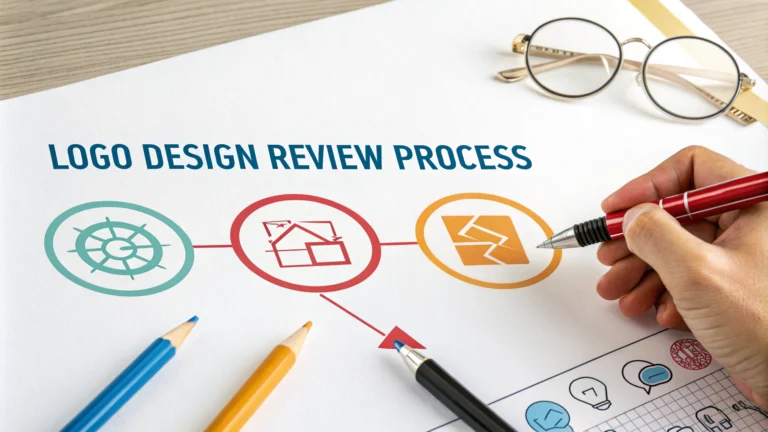A well-structured logo design review process helps ensure your brand mark meets business objectives and resonates with target audiences.
This quick guide outlines the key steps for evaluating logo designs effectively.
Initial Design Review Checklist
- Check scalability at different sizes (favicon to billboard)
- Test in black & white/grayscale versions
- Review against competitor logos for differentiation
- Assess alignment with brand values and positioning
- Evaluate technical requirements (file formats, color spaces)
Key Questions to Ask
- Does it work at small sizes without losing detail?
- Is it memorable and distinct from competitors?
- Does it reflect the brand personality?
- Will it appeal to the target audience?
- Can it work across all needed applications?
Technical Review Points
- Color accuracy across print and digital
- Font licensing and usage rights
- File format availability (.ai, .eps, .svg, etc.)
- Spacing and clearance requirements
- Trademark considerations
Stakeholder Feedback Process
- Share designs with key decision makers
- Collect structured feedback using evaluation forms
- Document all revision requests
- Prioritize changes based on business impact
- Set clear timelines for feedback rounds
Common Logo Design Issues to Watch For
- Overly complex details that won’t scale
- Poor color contrast affecting legibility
- Generic or cliché symbols
- Trendy elements that may date quickly
- Technical limitations for various uses
Final Approval Checklist
- All stakeholders have signed off
- Technical specifications are met
- Usage guidelines are documented
- File package is complete
- Legal clearance obtained if needed
Contact a professional logo designer through platforms like Behance or Dribbble for expert design services.
For trademark checks, consult the USPTO database or work with an intellectual property attorney.
Implementation Guidelines
- Create a brand style guide for consistent usage
- Define minimum size requirements
- Specify color codes for all applications
- Document spacing and placement rules
- Include examples of incorrect usage
Logo File Management
Essential File Formats
- Vector files (.ai, .eps, .svg)
- Raster files (.jpg, .png)
- Favicon versions (.ico)
- Social media optimized versions
- Print-ready formats
Ongoing Maintenance
- Regular review of usage compliance
- Updates to accommodate new platforms
- Periodic assessment of market relevance
- Documentation of any modifications
- Backup of all master files
Conclusion
A thorough logo review process ensures your brand mark will effectively serve its purpose across all applications. Regular evaluation and proper documentation help maintain brand consistency and protect your visual identity investment. Keep all stakeholders involved throughout the process and maintain comprehensive records of decisions and modifications.
Remember to periodically review your logo’s effectiveness and make updates as your brand evolves or new technical requirements emerge.
FAQs
1. What are the essential steps in a logo design review process?
The key steps are initial client briefing, concept presentation, gathering feedback, design refinement, final revisions, and approval. Each stage requires clear communication and documentation of changes requested.
2. How many revision rounds should be included in a logo design review process?
Professional logo design typically includes 2-3 revision rounds within the initial contract. Additional revisions may incur extra charges to maintain project scope and value.
3. What criteria should be considered when reviewing a logo design?
Evaluate scalability, simplicity, memorability, relevance to brand values, color appropriateness, versatility across different mediums, and uniqueness within the competitive landscape.
4. Who should be involved in the logo design review process?
Key stakeholders including business owners, marketing team, brand managers, and sometimes focus groups. However, limiting decision-makers to 2-3 core people helps maintain efficiency.
5. How long should each review cycle take in the logo design process?
Each review cycle should typically take 2-3 business days for client feedback, allowing the designer 2-4 days for implementing changes, totaling around 5-7 days per revision round.
6. What format should logo designs be presented in during reviews?
Logos should be presented in multiple formats: standalone, in context (mockups), different sizes, color variations, and on both light and dark backgrounds to demonstrate versatility.
7. How should feedback be collected and documented during the review process?
Feedback should be collected in writing through structured forms or email, with specific points addressing design elements, rather than vague comments, and centrally documented for reference.
8. What are the common pitfalls to avoid during logo design review?
Common pitfalls include design by committee, subjective personal preferences overruling brand objectives, rushing the process, and not testing the logo in various applications.
9. When should a logo design be considered final?
A logo design is final when it meets all technical specifications, works across all required applications, receives formal client approval, and passes trademark verification if required.
10. What deliverables should be reviewed in the final stage?
Final deliverables should include vector files (AI, EPS), various bitmap formats (JPEG, PNG), different color versions (CMYK, RGB, Pantone), style guide, and usage guidelines.








